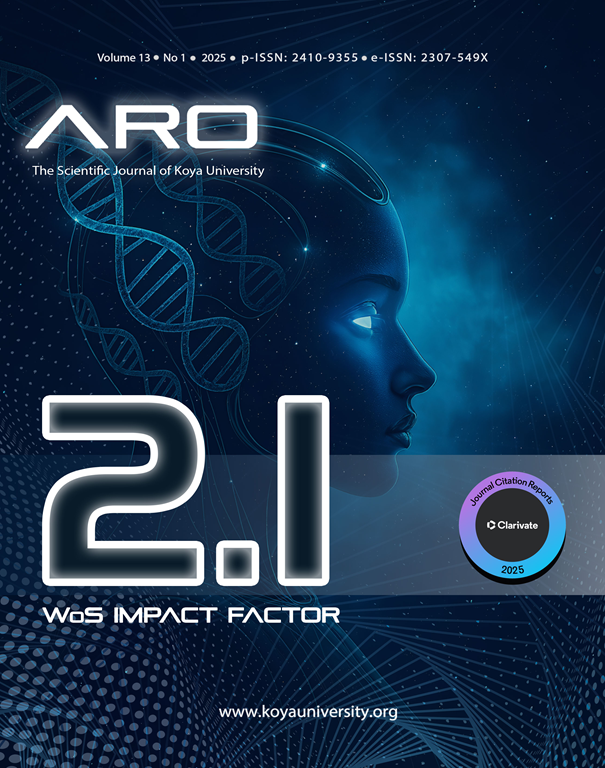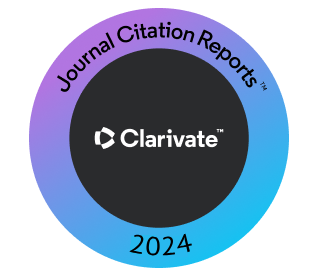Artificial Intelligence-based Digital Pathology Assessment of CD44s Expression in Breast Cancer
Association with Clinicopathological Features and Survival Outcomes
DOI:
https://doi.org/10.14500/aro.12248Keywords:
Artificial intelligence, Breast cancer stem cells, Breast cancer, CD44s, Immunohistochemistry, QuantCenterAbstract
Breast cancer (BC) exhibits considerable molecular and clinical heterogeneity, complicating prognostic evaluation. The cluster of differentiation 44 standard (CD44s) isoform has been proposed as a prognostic marker in various cancers; however, its role in BC remains unclear. This study evaluated CD44s expression in BC tissues and its association with clinicopathological features and survival outcomes using an artificial intelligence (AI)-based digital pathology scoring method. A retrospective analysis of 98 BC tissue samples is conducted, with CD44s cell membrane protein expression assessed through both manual and AI based immunohistochemical (IHC) scoring. Statistical analyses included Pearson’s chi-square test, Kaplan-Meier (log-rank), and Cox regression. CD44s expression was observed in 65.31% of patients. No significant associations are found between CD44s expression and clinicopathological characteristics, including age, tumor size, lymph node metastasis, histological grade, lymphovascular invasion (LVI), or hormone receptor status (all p > 0.05). Survival analysis reveals no significant association between CD44s expression and overall survival (OS, p = 0.1345) or progression-free survival (p = 0.0669). While CD44s expression is prevalent in BC samples, it is not an independent prognostic factor; LVI is the only significant predictor of OS (p = 0.036). Finally, the moderate agreement between AI and manual scoring (Cohen’s Kappa = 0.4337, p < 0.0001) supports the potential of AI-assisted methods for biomarker quantification, warranting further validation in larger cohorts.
Downloads
References
Abraham, B.K., Fritz, P., McClellan, M., Hauptvogel, P., Athelogou, M., and Brauch, H., 2005. Prevalence of CD44+/CD24−/low cells in breast cancer may not be associated with clinical outcome but may favour distant metastasis. Clinical Cancer Research, 11(3), pp.1154-1159. DOI: https://doi.org/10.1158/1078-0432.1154.11.3
Acs, B., Pelekanou, V., Bai, Y., Martinez-Morilla, S., Toki, M., Leung, S.C., Nielsen, T.O., and Rimm, D.L., 2019. Ki67 reproducibility using digital image analysis: An inter-platform and inter-operator study. Laboratory Investigation, 99(1), pp.107-117. DOI: https://doi.org/10.1038/s41374-018-0123-7
Aeffner, F., Adissu, H.A., Boyle, M.C., Cardiff, R.D., Hagendorn, E., Hoenerhoff, M.J., Klopfleisch, R., Newbigging, S., Schaudien, D., Turner, O., and Wilson, K., 2018. Digital microscopy, image analysis, and virtual slide repository. ILAR journal, 59(1), pp.66-79. DOI: https://doi.org/10.1093/ilar/ily007
Al-Hajj, M., Wicha, M.S., Benito-Hernandez, A., Morrison, S.J., and Clarke, M.F., 2003. Prospective identification of tumorigenic breast cancer cells. Proceedings of the National Academy of Sciences, 100(7), pp.3983-3988. DOI: https://doi.org/10.1073/pnas.0530291100
Barnard, M.E., Boeke, C.E., and Tamimi, R.M., 2015. Established breast cancer risk factors and risk of intrinsic tumour subtypes. Biochimica Biophysica Acta (BBA)-Reviews on Cancer, 1856(1), pp.73-85. DOI: https://doi.org/10.1016/j.bbcan.2015.06.002
Bei, Y., Cheng, N., Chen, T., Shu, Y., Yang, Y., Yang, N., Zhou, X., Liu, B., Wei, J., Liu, Q., Zheng, W., Zhang, W., Su, H., Zhu, W., Ji, J., and Shen, P., 2020. CDK5 inhibition abrogates TNBC stem‐cell property and enhances anti‐PD‐1 therapy. Advanced Science, 7(22), p.2001417. DOI: https://doi.org/10.1002/advs.202001417
Braun, M., Piasecka, D., Bobrowski, M., Kordek, R., Sadej, R., and Romanska, H.M., 2020. A ‘Real-Life’experience on automated digital image analysis of FGFR2 immunohistochemistry in breast cancer. Diagnostics(Basel), 10(12), p.1060. DOI: https://doi.org/10.3390/diagnostics10121060
Bray, F., Laversanne, M., Sung, H., Ferlay, J., Siegel, R.L., Soerjomataram, I., and Jemal, A., 2024. Global cancer statistics 2022: GLOBOCAN estimates of incidence and mortality worldwide for 36 cancers in 185 countries. CA: A Cancer Journal for Clinicians, 74(3), pp.229-263. DOI: https://doi.org/10.3322/caac.21834
Brown, R.L., Reinke, L.M., Damerow, M.S., Perez, D., Chodosh, L.A., Yang, J., and Cheng, C., 2011. CD44 splice isoform switching in human and mouse epithelium is essential for epithelial-mesenchymal transition and breast cancer progression. The Journal of Clinical Investigation, 121(3), pp.1064-1074. DOI: https://doi.org/10.1172/JCI44540
Bustreo, S., Osella-Abate, S., Cassoni, P., Donadio, M., Airoldi, M., Pedani, F., Papotti, M., Sapino, A., and Castellano, I., 2016. Optimal Ki67 cut-off for luminal breast cancer prognostic evaluation: A large case series study with a long-term follow-up. Breast Cancer Research and Treatment, 157, pp.363-371. DOI: https://doi.org/10.1007/s10549-016-3817-9
Cho, Y., Lee, H.W., Kang, H.G., Kim, H.Y., Kim, S.J., and Chun, K.H., 2015. Cleaved CD44 intracellular domain supports activation of stemness factors and promotes tumorigenesis of breast cancer. Oncotarget, 6(11), pp.8709-8721. DOI: https://doi.org/10.18632/oncotarget.3325
Clark, G.C., Hampton, J.D., Koblinski, J.E., Quinn, B., Mahmoodi, S., Metcalf, O., Guo, C., Peterson, E., Fisher, P.B., Farrell, N.P., Wang, X.Y., and Mikkelsen, R.B., 2022. Radiation induces ESCRT pathway dependent CD44v3+ extracellular vesicle production stimulating pro-tumor fibroblast activity in breast cancer. Frontiers in Oncology, 12, p.913656. DOI: https://doi.org/10.3389/fonc.2022.913656
Dai, X., Li, T., Bai, Z., Yang, Y., Liu, X., Zhan, J., and Shi, B., 2015. Breast cancer intrinsic subtype classification, clinical use and future trends. American Journal of Cancer Research, 5(10), pp.2929-2943. DOI: https://doi.org/10.1371/journal.pone.0124964
Elston, C.W., and Ellis, I.O., 1991. Pathological prognostic factors in breast cancer. I. The value of histological grade in breast cancer: Experience from a large study with long‐term follow‐up. Histopathology, 19(5), pp.403-410. DOI: https://doi.org/10.1111/j.1365-2559.1991.tb00229.x
Giuliano, A.E., Edge, S.B., and Hortobagyi, G.N., 2018. Eighth edition of the AJCC cancer staging manual: Breast cancer. Annals of Surgical Oncology, 25, pp.1783-1785. DOI: https://doi.org/10.1245/s10434-018-6486-6
Gong, Y., Sun, X., Huo, L., Wiley, E.L., and Rao, M.S., 2005. Expression of cell adhesion molecules, CD44s and E‐cadherin, and microvessel density in invasive micropapillary carcinoma of the breast. Histopathology, 46(1), pp.24-30. DOI: https://doi.org/10.1111/j.1365-2559.2004.01981.x
Goodison, S., Urquidi, V., and Tarin, D., 1999. CD44 cell adhesion molecules. Molecular Pathology, 52(4), pp.189-196. DOI: https://doi.org/10.1136/mp.52.4.189
Gu, J., Chen, D., Li, Z., Yang, Y., Ma, Z., and Huang, G., 2022. Prognosis assessment of CD44+/CD24− in breast cancer patients: A systematic review and meta-analysis. Archives of Gynecology and Obstetrics, 306(4), pp.1147-1160. DOI: https://doi.org/10.1007/s00404-022-06402-w
Guo, Q., Liu, Y., He, Y., Du, Y., Zhang, G., Yang, C., and Gao, F., 2021. CD44 activation state regulated by the CD44v10 isoform determines breast cancer proliferation. Oncology Reports, 45(4), p.7. DOI: https://doi.org/10.3892/or.2021.7958
Herrera-Gayol, A., and Jothy, S., 1999. Adhesion proteins in the biology of breast cancer: Contribution of CD44. Experimental and Molecular Pathology, 66(2), pp.149-156. DOI: https://doi.org/10.1006/exmp.1999.2251
Hu, J., Li, G., Zhang, P., Zhuang, X., and Hu, G., 2017. A CD44v+ subpopulation of breast cancer stem-like cells with enhanced lung metastasis capacity. Cell Death Disease, 8(3), p.e2679. DOI: https://doi.org/10.1038/cddis.2017.72
Lee, K., Kruper, L., Dieli-Conwright, C.M., and Mortimer, J.E., 2019. The impact of obesity on breast cancer diagnosis and treatment. Current Oncology Reports, 21, p.41. DOI: https://doi.org/10.1007/s11912-019-0787-1
Lee, S.J., Go, J., Ahn, B.S., Ahn, J.H., Kim, J.Y., Park, H.S., Kim, S.I., Park, B.W., and Park, S., 2023. Lymphovascular invasion is an independent prognostic factor in breast cancer irrespective of axillary node metastasis and molecular subtypes. Frontiers in Oncology, 13, p.1269971. DOI: https://doi.org/10.3389/fonc.2023.1269971
Liu, Y., Han, D., Parwani, A.V., and Li, Z., 2023. Applications of artificial intelligence in breast pathology. Archives of Pathology and Laboratory Medicine, 147(9), pp.1003-1013. DOI: https://doi.org/10.5858/arpa.2022-0457-RA
Lopez, J.I., Camenisch, T.D., Stevens, M.V., Sands, B.J., McDonald, J., and Schroeder, J.A., 2005. CD44 attenuates metastatic invasion during breast cancer progression. Cancer Research, 65(15), pp.6755-6763. DOI: https://doi.org/10.1158/0008-5472.CAN-05-0863
McCaffrey, C., Jahangir, C., Murphy, C., Burke, C., Gallagher, W.M., and Rahman, A., 2024. Artificial intelligence in digital histopathology for predicting patient prognosis and treatment efficacy in breast cancer. Expert Review of Molecular Diagnostics, 24(5), pp.363-377. DOI: https://doi.org/10.1080/14737159.2024.2346545
Mohamed, S.Y., Kaf, R.M., Ahmed, M.M., Elwan, A., Ashour, H.R., and Ibrahim, A., 2019. The prognostic value of cancer stem cell markers (Notch1, ALDH1, and CD44) in primary colorectal carcinoma. Journal of Gastrointestinal Cancer, 50, pp.824-837. DOI: https://doi.org/10.1007/s12029-018-0156-6
Nishimura, R., Osako, T., Okumura, Y., Nakano, M., Ohtsuka, H., Fujisue, M., and Arima, N., 2022. An evaluation of lymphovascular invasion in relation to biology and prognosis according to subtypes in invasive breast cancer. Oncology Letters, 24(2), p.245. DOI: https://doi.org/10.3892/ol.2022.13366
Pati, P., Karkampouna, S., Bonollo, F., Compérat, E., Radić, M., Spahn, M., Martinelli, A., Wartenberg, M., Kruithof-de Julio, M., and Rapsomaniki, M., 2024. Accelerating histopathology workflows with generative AI-based virtually multiplexed tumor profiling. Nature Machine Intelligence, 6(9), pp.1077-1093. DOI: https://doi.org/10.1038/s42256-024-00889-5
Paulsen, I.M.S., Dimke, H., and Frische, S., 2015. A single simple procedure for dewaxing, hydration and heat-induced epitope retrieval (HIER) for immunohistochemistry in formalin fixed paraffin-embedded tissue. European Journal of Histochemistry EJH, 59(4), p.2532. DOI: https://doi.org/10.4081/ejh.2015.2532
Rakha, E.A., Vougas, K., and Tan, P.H., 2022. Digital technology in diagnostic breast pathology and immunohistochemistry. Pathobiology, 89(5), pp.334-342. DOI: https://doi.org/10.1159/000521149
Schmitt, F., Ricardo, S., Vieira, A.F., Dionísio, M.R., and Paredes, J., 2012. Cancer stem cell markers in breast neoplasias: Their relevance and distribution in distinct molecular subtypes. Virchows Archiv, 460, pp.545-553. DOI: https://doi.org/10.1007/s00428-012-1237-8
Senbanjo, L.T., and Chellaiah, M.A., 2017. CD44: A multifunctional cell surface adhesion receptor is a regulator of progression and metastasis of cancer cells. Frontiers in Cell and Developmental Biology, 5, p.18. DOI: https://doi.org/10.3389/fcell.2017.00018
Somal, P.K., Sancheti, S., Sharma, A., Sali, A.P., Chaudhary, D., Goel, A., Dora, T.K., Brar, R., Gulia, A., and Divatia, J., 2023. A clinicopathological analysis of molecular subtypes of breast cancer using immunohistochemical surrogates: A 6-year institutional experience from a tertiary cancer center in north India. South Asian Journal of Cancer, 12(02), pp.104-111. DOI: https://doi.org/10.1055/s-0043-1761942
Song, Y.J., Shin, S.H., Cho, J.S., Park, M.H., Yoon, J.H., and Jegal, Y.J., 2011. The role of lymphovascular invasion as a prognostic factor in patients with lymph node-positive operable invasive breast cancer. Journal of Breast Cancer, 14(3), pp.198-203. DOI: https://doi.org/10.4048/jbc.2011.14.3.198
Steinbichler, T.B., Dudás, J., Skvortsov, S., Ganswindt, U., Riechelmann, H., and Skvortsova, I.I., 2018. December. Therapy resistance mediated by cancer stem cells. In: Seminars in Cancer Biology. Vol. 53. Academic Press, United States, pp.156-167. DOI: https://doi.org/10.1016/j.semcancer.2018.11.006
Turner, K.M., Yeo, S.K., Holm, T.M., Shaughnessy, E., and Guan, J.L., 2021. Heterogeneity within molecular subtypes of breast cancer. American Journal of Physiology Cell Physiology, 321(2), pp.C343-C354. DOI: https://doi.org/10.1152/ajpcell.00109.2021
Vadhan, A., Hou, M.F., Vijayaraghavan, P., Wu, Y.C., Hu, S.C.S., Wang, Y.M., Cheng, T.L., Wang, Y.Y., and Yuan, S.S.F., 2022. CD44 promotes breast cancer metastasis through AKT-mediated downregulation of nuclear FOXA2. Biomedicines, 10(10), p.2488. DOI: https://doi.org/10.3390/biomedicines10102488
Vallejos, C.S., Gómez, H.L., Cruz, W.R., Pinto, J.A., Dyer, R.R., Velarde, R., Suazo, J.F., Neciosup, S.P., León, M., De La Cruz, M.A., and Vigil, C.E., 2010.
Breast cancer classification according to immunohistochemistry markers: Subtypes and association with clinicopathologic variables in a peruvian hospital database. Clinical Breast Cancer, 10(4), pp.294-300. DOI: https://doi.org/10.3816/CBC.2010.n.038
Walcher, L., Kistenmacher, A.K., Suo, H., Kitte, R., Dluczek, S., Strauß, A., Blaudszun, A.R., Yevsa, T., Fricke, S., and Kossatz-Boehlert, U., 2020. Cancer stem cells-origins and biomarkers: Perspectives for targeted personalized therapies. Frontiers in Immunology, 11, p.1280. DOI: https://doi.org/10.3389/fimmu.2020.01280
Wilson, M.M., Weinberg, R.A., Lees, J.A., and Guen, V.J., 2020. Emerging mechanisms by which EMT programs control stemness. Trends in Cancer, 6(9), pp.775-780. DOI: https://doi.org/10.1016/j.trecan.2020.03.011
Winters, S., Martin, C., Murphy, D., and Shokar, N.K., 2017. Breast cancer epidemiology, prevention, and screening. Progress in Molecular Biology and Translational Science, 151, pp.1-32. DOI: https://doi.org/10.1016/bs.pmbts.2017.07.002
Wu, Q., Yang, Y., Wu, S., Li, W., Zhang, N., Dong, X., and Ou, Y., 2015. Evaluation of the correlation of KAI1/CD82, CD44, MMP7 and β-catenin in the prediction of prognosis and metastasis in colorectal carcinoma. Diagnostic Pathology, 10, p.176. DOI: https://doi.org/10.1186/s13000-015-0411-0
Wu, S., Yue, M., Zhang, J., Li, X., Li, Z., Zhang, H., Wang, X., Han, X., Cai, L., Shang, J., Jia, Z., Wang, X., Li, J., and Liu, Y., 2023. The role of artificial intelligence in accurate interpretation of HER2 immunohistochemical scores 0 and 1+ in breast cancer. Modern Pathology, 36(3), p.100054. DOI: https://doi.org/10.1016/j.modpat.2022.100054
Wu, X.J., Li, X.D., Zhang, H., Zhang, X., Ning, Z.H., Yin, Y.M., and Tian, Y., 2015. Clinical significance of CD44s, CD44v3 and CD44v6 in breast cancer. Journal of International Medical Research, 43(2), pp.173-179. DOI: https://doi.org/10.1177/0300060514559793
Xiong, X., Zheng, L.W., Ding, Y., Chen, Y.F., Cai, Y.W., Wang, L.P., Huang, L., Liu, C.C., Shao, Z.M., and Yu, K.D., 2025. Breast cancer: Pathogenesis and treatments. Signal Transduction and Targeted Therapy, 10(1), p.49. DOI: https://doi.org/10.1038/s41392-024-02108-4
Yang, C., Cao, M., Liu, Y., He, Y., Du, Y., Zhang, G., and Gao, F., 2019. Inducible formation of leader cells driven by CD44 switching gives rise to collective invasion and metastases in luminal breast carcinomas. Oncogene, 38(46), pp.7113-7132. DOI: https://doi.org/10.1038/s41388-019-0899-y
Zahwe, M., Bendahhou, K., Eser, S., Mukherji, D., Fouad, H., Fadhil, I., Soerjomataram, I., and Znaor, A., 2025. Current and future burden of female breast cancer in the Middle East and North Africa region using estimates from GLOBOCAN 2022. International Journal of Cancer, 156, pp.2320-2329. DOI: https://doi.org/10.1002/ijc.35325
Zhang, H., Brown, R.L., Wei, Y., Zhao, P., Liu, S., Liu, X., Deng, Y., Hu, X., Zhang, J., Gao, X.D., Kang, Y., Mercurio, A.M., Goel, H.L., and Cheng, C., 2019. CD44 splice isoform switching determines breast cancer stem cell state. Genes and Development, 33(3-4), pp.166-179 DOI: https://doi.org/10.1101/gad.319889.118
Downloads
Published
How to Cite
Issue
Section
License
Copyright (c) 2025 Avan S. Mohammed, Ramadhan T. Othman, Rafil T. Yaqo

This work is licensed under a Creative Commons Attribution-NonCommercial-ShareAlike 4.0 International License.
Authors who choose to publish their work with Aro agree to the following terms:
-
Authors retain the copyright to their work and grant the journal the right of first publication. The work is simultaneously licensed under a Creative Commons Attribution License [CC BY-NC-SA 4.0]. This license allows others to share the work with an acknowledgement of the work's authorship and initial publication in this journal.
-
Authors have the freedom to enter into separate agreements for the non-exclusive distribution of the journal's published version of the work. This includes options such as posting it to an institutional repository or publishing it in a book, as long as proper acknowledgement is given to its initial publication in this journal.
-
Authors are encouraged to share and post their work online, including in institutional repositories or on their personal websites, both prior to and during the submission process. This practice can lead to productive exchanges and increase the visibility and citation of the published work.
By agreeing to these terms, authors acknowledge the importance of open access and the benefits it brings to the scholarly community.
Accepted 2025-06-02
Published 2025-06-22
















 ARO Journal is a scientific, peer-reviewed, periodical, and diamond OAJ that has no APC or ASC.
ARO Journal is a scientific, peer-reviewed, periodical, and diamond OAJ that has no APC or ASC.